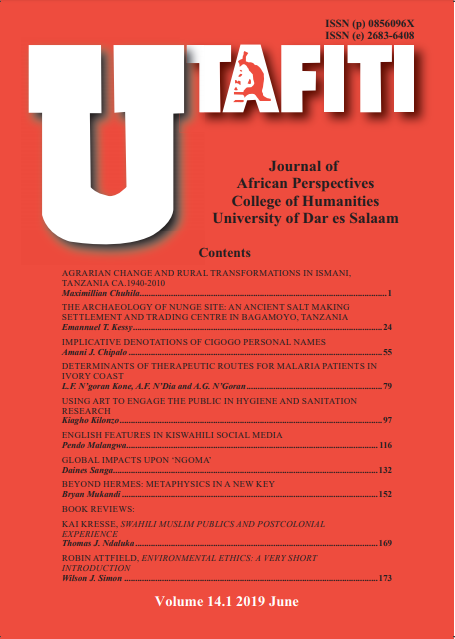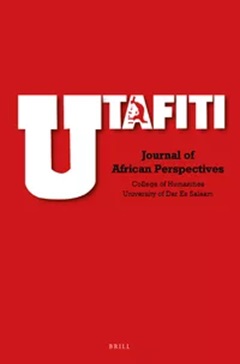ENGLISH FEATURES IN KISWAHILI SOCIAL MEDIA
Abstract
All languages are transformed to some extent by other languages with which they are regularly in contact. Some languages are regarded as ' developed ' insofar as they function as the dominant mode of communication in economically developed countries (e.g. in North America and Europe). The dominant speech communities of rich economies transmit new innovations and discoveries globally, which are then translated into languages described as ' developing ' because their use is chiefly restricted to so-called economically developing nations, such as Tanzania. In this respect, English counts among the world ' s developed languages while Kiswahili is regarded as a developing language. Despite the general tendency to translate new expressions fully into a targeted developing language, there is evidence of foreign structures in Kiswahili when it is used in social media. This article analyses the English syntactic, morphological, phonological and lexical features of Kiswahili appearing in electronic platforms including WhatsApp, personal blogs (e.g. Michuziblogspot) and online social forums (e.g. Jamii Forum). This primary data is then analysed through back translation.
Key Words: translation features, language, social media, markedness, borrowing
References
Auer, P. and Wei, L. 2007. Multilingualism as a Problem? Monolingualism as a Problem? In Handbook of Multilingualism and Multilingualism Communication. Eds. P. Auer and L. Wei. Berlin: De Gruyter Mouton, pp. 1-14.
Catford, J.C. 1965. A Linguistic Theory of Translation. London: Oxford University Press.
Chen, L. 2009. On Literal Translation of English Idioms. English Language Teaching 2(2): 164-166.
Coulmas, F. 2013. Sociolinguistics: The Study of Speakers ' Choices. Second edition. Cambridge: Cambridge University Press.
El-dadi, H.M. 2011. Towards an Understanding of the Distinctive Nature of Translation Studies. Journal of King Saud University-Languages and Translation Journal 23(1): 29-45.
Gafaranga, J. 2012. Language Alteration and Conversational Pair in Bilingual Conversation. International Journal of Bilingualism 16(4): 501-527.
Gafaranga, J. 2007. Talk in Two Languages. Basingstoke: Palgrave Macmillan.
Gafaranga, J. 2007. Code-switching as a Conversational Strategy. In Handbook of Multilingualism and Multilingualism
Communication. Eds. P. Auer and L. Wei. Berlin: De Gruyter Mouton, pp. 279-314.
Gross, S. 2009. Code-switching. In Concise Encyclopedia of Pragmatics. Ed. Jacob L. Mey. Oxford: Elsevier Science and Technology, pp. 67-70.
Hassan, B. A. 2011. Literary Translation: Aspects of Pragmatic Meaning. Newcastle upon Tyne: Cambridge Scholars Publishing.
Heine, B. and Kuteva, T. 2005. Language Contact and Grammatical Change. Cambridge: Cambridge University Press.
Kamwangamalu, N. M. 2010. Multilingualism and Code-switching in Education. In Sociolinguistics and Language Education. Eds. Nancy H. Hornberger and Sandra Lee McKay. Bristol: Multilingual Matters, pp. 116-142.
Kihore, Y. M. 1989. Linguistics and Translation from and into African Languages. In Problems of Translation in Africa. Roundtable proceedings of the International Federation of Translators (FIT). Dar es Salaam, August 28-30. UNESCO, pp. 47-51.
Lanza, E. 2007. Multilingualism and the Family. In Handbook of
Multilingualism and Multilingualism Communication. Eds. P. Auer
and L. Wei. Berlin: De Gruyter Mouton, pp. 45-68.
Malangwa, P.S. 2014. Challenges of Translating Cultural Expressions in Teaching Kiswahili to Foreigners. Kiswahili Journal 77: 104-117.
Makaryk, I. R. 1993. Encyclopedia of Contemporary Literary Theory: Approaches, Scholars, Terms. Toronto: Toronto University Press.Myers-Scotton, C. Ed. 1998. A Theoretical Introduction to the Markedness Model. In Codes and Consequences: choosing linguistic varieties. Ed. C. Myers-Scotton. New York: Oxford University Press, pp.18-38.
Myers-Scotton, C. 1993. Dueling Languages: Grammatical Structure in Code-switching. Oxford: Clarendon.
Newmark, P. 1988. A Textbook of Translation. London: Prentice Hall.
Nida, E.A. 1986. From One Language to Another. Shanghai: Shanghai Foreign Language Education Press.
Paradis, J. 2007. Early Bilingualism and Multilingualism Acquisition. In Handbook of Multilingualism and Multilingualism Communication. Eds. P. Auer and L. Wei. Berlin: De Gruyter Mouton, pp. 15-44.
Ping, K. 1996. A Socio-Semiotic Approach to Meaning in Translation. Babel 42(2): 74-81.
Porter, S. E. and Hess, R. S. 2004. Translating the Bible: Problems and Prospects. Rome: Continuum International Publishing Group.
Nida, E. A. and Taber, C.R. 1969. The Theory and Practice of Translation. Leiden: E.J. Brill.
Ulvydiene, L. 2013. Psychology of Translation in Cross-Cultural Interaction. Procedia-Social and Behavioral Sciences 84: 1889-1898.
Webster ' s New World Dictionary of the American English. 1988. Third college edition 1988. New York: Webster.
Yan-qiun, Z. and Feng-Juan, T. 2015. Study on Markedness in Linguistics. Sino-US English Teaching 12(9): 667-671.



